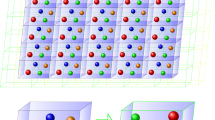Summary
The boundary energy terms dependent on the first derivative of the director are analysed theoretically. Although these terms necessarily arise from nonlocal interactions, they are generally written as purely surface terms. We show that, in this case, the stable director configurations are described by functions with discontinuous derivatives at the boundaries. All the solutions given in literature, which are found by explicitly assuming the continuity of the derivatives, must, therefore, be revised. In a more correct formulation of the problem, the ranges of the interaction forces should be taken into account and continuous solutions are then obtained, which are generally well approximated by the discontinuous ones. The approximation, instead, is not good in the case of the energy term proposed by Dubois-Violette and Parodi, where the discontinuity has the form of a Dirac function. In this case a physically meaningful solution can be found only on the basis of a more suitable expression of the boundary energy.
Riassunto
I termini di energia superficiale dipendenti dalla derivata prima del direttore sono analizzati teoricamente. Benché tali termini nascano necessariamente da interazioni non locali, essi sono generalmente scritti come termini di superficie puri. Noi mostriamo che in questo caso le configurazioni stabili del direttore sono descritte da funzioni con derivate discontinue ai contorni. Ne segue che tutte le soluzioni riportate in letteratura che sono trovate assumendo esplicitamente la continuità delle derivate devono essere riviste. In una formulazione piú corretta del problema gli intervalli delle forze d'interazione dovrebbero essere presi in considerazione, ed in questo caso si ottengono soluzioni continue, che sono generalmente ben approssimate da quelle discontinue. L'approssimazione invece non è buona nel casc di termini di energia aventi la forma proposta da Dubois-Violette e Parodi, dove la discontinuità ha la forma di una δ di Dirac. In questo caso soluzioni fisicamente significative possono essere trovate soltanto sulla base di una piú adatta espressione per l'ernergia dello strato superficiale.
Similar content being viewed by others
References
See, for example,P. G. de Gennes:The Physics of Liquid Crystals (Clarendon Press, Oxford, 1974).
G. Barbero, N. V. Madhusudana andG. Durand:Z. Naturforsch., Teil A,39, 1066 (1984), and references therein.
H. Mada:Mol. Cryst. Liq. Cryst.,51, 43 (1979).
C. W. Oseen:Faraday Soc.,29, 833 (1933).
J. Nehring andA. Saupe:J. Chem. Phys.,54, 337 (1971).
S. Shimoda, H. Mada andS. Kobayashi:The Physics and Chemistry of Liquid Crystal Devices, edited byG. J. Sprokel (Plenum Press, New York, N. Y., 1980), p. 47.
H. Mada:Appl. Phys. Lett.,39, 701 (1981).
H. Mada:Mol. Cryst. Liq. Cryst. Lett.,82, 53 (1982).
H. A. Van Sprang:J. Phys. (Paris),44, 421 (1983).
A. I. Derzhanski andH. P. Hinov:Phys. Lett. A,56, 465 (1976).
H. P. Hinov:J. Phys. (Paris) Lett.,38, 215 (1977).
A. I. Derzhanski andH. P. Hinov:J. Phys. (Paris),38, 1013 (1977).
H. P. Hinov andA. I. Derzhanski:J. Phys. (Paris) Colloq.,40, C3–305 (1979).
M. I. Barnik, L. M. Blinov, T. V. Korkisho, B. A. Umanski andV. G. Chrigrinov:Mol. Cryst. Liq. Cryst.,99, 53 (1983).
M. I. Barnik, L. M. Blinov, T. V. Korkishko, B. A. Umanski andV. G. Chrigrinov:Soc. Phys. JETP.,58, 102 (1984).
G. Barbero, R. Bartolino andM. Meuti:J. Phys. (Paris) Lett.,45, 449 (1984).
G. Barbero andA. Strigazzi:J. Phys. (Paris) Lett.,45, 857 (1984).
E. Dubois-Violette andO. ParodiJ. Phys. (Paris) Colloq.,30, C4–57 (1969).
V. Smirnov:Cours de Mathématiques Superieures, Vol.4, Tome 2 (MIR, Moscow, 1969).
R. S. Schechter:The Variational Method in Engineering (McGraw-Hill, New York, N. Y., 1967).
L. Elsgolts:Differential Equations and the Calculus of Variations (MIR, Moscow, 1977).
M. L. Krasnov, G. I. Makarenko andA. I. Kiselev:Problems in the Calculus of Variations (MIR, Moscow, 1984).
R. Weinstock:Calculus of Variations, with Applications of Physics and Engineering (McGraw-Hill, New York, N. Y., 1952).
E. Dubois-Violette andP. G. de Gennes:J. Phys. Lett. (Paris),36, L-255 (1975).
A. L. Cauchy:Memoire sur les systèmes isotrope des points materials Oeuvres.
Author information
Authors and Affiliations
Additional information
Work supported by CNR under contract No. 84.01186.11.
Rights and permissions
About this article
Cite this article
Barbero, G., Oldano, C. Derivative-dependent surface-energy terms in nematic liquid crystals. Il Nuovo Cimento D 6, 479–493 (1985). https://doi.org/10.1007/BF02451904
Received:
Issue Date:
DOI: https://doi.org/10.1007/BF02451904




